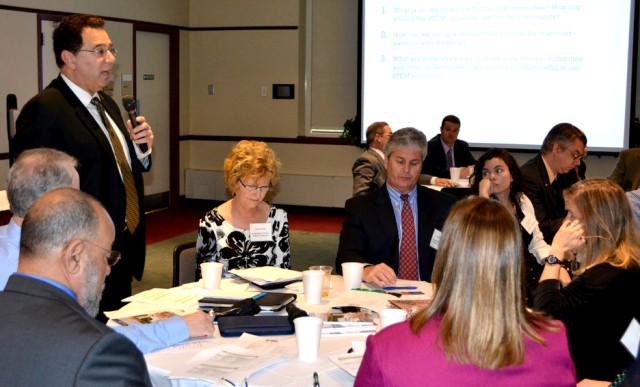NORTHEAST, Md. - About 120 area educators, industry leaders and government employees convened at Cecil College April 28 for STEM Summit II, the second in a series of meetings that is striving to develop a regional culture attune to science, technology, engineering and mathematics career development.
"It's an azimuth check," said Gary Martin, executive deputy to the commanding general, U.S. Army Research, Development and Engineering Command. "At the first STEM Summit we identified four working groups and this is the next step."
Hosted by the Northeast Maryland Technology Council, attendees were welcomed by John Casner, executive director of the NMTC. After a gracious welcome by Cecil College President Dr. W. Stephen Pannil, Casner set the focus for the day's event.
"We're here to stimulate the program and expand the pipeline," Casner said. "We must be ever mindful of STEM enrichment activities and support the process. Not only do we need community participation, but we must also work to strategically communicate it to others."
Casner then introduced Joan Michel of Profile Partners who served as facilitator for the summit.
"Our 'Technopolis' needs a tech workforce," Michel said, addressing the many STEM initiatives currently taking place in the region.
"This summit seeks to organize government and industry efforts in supporting entries responsible for delivering STEM education," Michel said. She then outlined the efforts of the four working groups.
"Each of the four committees focused on an area we felt was vital to fully address STEM development," she said. The four areas are: Students, Teachers, STEM Content, and Strategic Communications.
"STEM is this enormous elephant in the room," Michel continued. "The only way forward was to break it down into themes that we connect with student age."
Theme for students pre-Kindergarten to grade five is to "Excite" them by exposing them to STEM. For grades 6-8, the theme is to "Expand" their interest in STEM fields. In grades 9-12, the theme is to "Focus" on STEM careers. In their college years, students "Finish" their education. Beyond college, the theme is to "Employ" successful STEM students.
"It's best to reach students early, before grade five," Michel said. "And we do that with math, math, math, and math. In grades 6-8, soft skills are needed because teachers have difficult needs due to the extraordinary range of students in the room."
Michel then introduced each committee chair, who explained what their group worked on and presented their findings. After each presentation, attendees were separated into three groups and asked to respond to one question relative to the presentation they had just heard.
Diane Lane, Cecil College, began by discussing the efforts of the first working group which focused on Students.
"Students are at the heart of all this," Lane said, acknowledging that every group was tackling what they thought was the most important issue.
"The richness in our group was amazing," she added.
The group's purpose was to "Stimulate student participation in STEM disciplines." They developed a course of action that includes: identifying programming and resources to attract students, to support students as they pursue STEM paths, to thread STEM awareness into each phase of a student's education, to develop strategies to implement programming, and to target underrepresented groups.
Lane addressed some of her group's concerns.
"Where do we go' How do we get high school kids to help K-5 kids' We all know to master something you have to teach it, and that's why a mentorship program is so important," she said.
"And we really have to expand STEM for students in grades 6-8," Lane continued, "hands-on events, and career information and cohort opportunities. Kids hit a wall in middle school so we need to drill down to fundamentals. And math - that's the wall for most of them."
"We need a challenging program, but compromises are needed," she said. "Part of the resources we have are each other. And none of the students should feel isolated. Cohorts move it forward."
The Teacher committee report was filed by Sandy Young, a scientist from Army Research Laboratory. The STEM Content committee was chaired by Tamera Rush, from SRC, and the Strategic Communications committee was chaired by Bob Carullo of Sabre Systems. Discussions after each presentation were lively and thought-provoking.
Jason Parks, a fifth grade teacher from Harford County Public Schools, raised an important teacher issue as he told the group his being there was due to his personal interest, and that he had to ask permission to attend.
"Job development is assigned to teachers," Parks said. "Our choice comes in summer. What's needed is to allow teachers to choose to use their time for professional development. And we need to make sure this is an ongoing process. All too often it's a one-shot professional development program then it's left to the teacher."
"Like most in attendance, I was impressed with the depth and work done by the committees in only two months," Casner, the event host, said. "I thought the committees were thorough, well organized and purposeful. All of the elements that are needed to go forward were there."
"We all think this is significant or we wouldn't be here," Martin said during one of the discussion periods. "But let's not re-invent the wheel. We need to seek out programs that are out there, similar mechanisms that already exist, and start there."
The next STEM Summit is scheduled for July 28. Casner said the goal at that event will be to implement an action plan, turning the findings of the committees into a plan that will effect change in the future.




Social Sharing